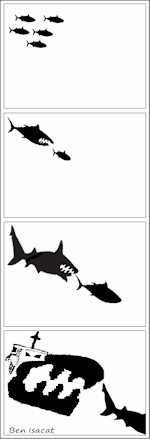
 |
|
|
Fish StatisticsSummary Assuming the data in the tables below for the year 2001 are typical for recent years:
Wild Caught FishPeople catch annually about 100 million tons of wild fish from the seas and oceans. This is nearly a five-fold increase over 1950 when people took about 20 million tonnes of fish per year. Around 3.5 million boats fish the seas and oceans worldwide, with Russia and US owning the largest fleets of deepwater fishing boats. Britain, once an imperial sea power, ranked 21st in 2001 with 0.7 million tonnes of wild caught fish.
For the source of these figures see Notes, below. The World's Three Most Wild Caught Fish By weight. 1 tonne = 1 ton.  1. Peruvian anchovy (Engraulis ringens). Also called the Peruvian anchoveta. 7.2 million tonnes in 2001. Maximum length 20 cm (8 ins). Prefers sub-tropical waters, swims in massive shoals, particularly off Peru and Chile. A filter-feeder on plankton.  2. Walleye Pollock (Theragra chalcogramma). Also called Alaska Pollock. 3.1 million tones in 2001. Length up to 80 cm (2 foot 6 ins). Lives throughout the north Pacific. Can live up to 15 years.  3. Chilean jack mackerel (Trachurus murphyi). 2.5 million tonnes in 2001. Length up to 70 cm (2 foot 4 ins). Found in south Pacific and south-west Atlantic. Feeds mainly on fish larvas and small shell fish. Can live up to 16 years.  Source of tonnage data from Food and Agriculture Organization of the United Nations, Fishery Information, Data and Statistics Unit. (Web site accessed February 2008.)Farmed FishPeople farm about 38 million tonnes of fish per year. This is a 38-fold increase since 1950 when about one million tonnes was farmed. In 2001 the US ranked 10th at 0.5 million tonnes of farmed fish and Britain ranked 19th with 0.2 million tonnes of farmed fish.
For the source of these figures see Notes, below. The World's Three Most Farmed Fish/Shellfish By weight. 1 tonne = 1 ton.  1. Pacific king oyster (Crassostrea gigas). Also called Japanese oyster. 4.2 million tonnes in 2001. Usually 8 to 30 cm long (8 to 12 inch), a filter feeding oyster favouring shallow waters, introduced around the world from Japan. Reared primarily in estuaries.  2. Grass Carp (Ctenopharyngodon idellus). 3.4 million tonnes in 2001. Grows up to 1.5 m and 45 kg (5 foot and 90 lbs). Lives in lakes and rivers. Original home was China and eastern Siberia and now introduced around the world. Feeds on plants and invertebrates. Maximum reported age is 21 years.  3. Silver carp (Hypophthalmichthys molitrix). 2.9 million tonnes in 2001. Grows up to 1.0 m and 50 kg (3 foot 3 inch and 110 lbs). Enjoys slow flowing waters of large rivers. Original home China and eastern Siberia but introduced around the world. Feeds on phytoplankton and zooplankton. Source of tonnage data from Food and Agriculture Organization of the United Nations, Fishery Information, Data and Statistics Unit. (Web site accessed February 2008.)Notes Source of figures for Table 1 is S Vannuccini (2003): Overview Of Fish Production, Utilization, Consumption & Trade. Food & Agriculture Organization of the United Nations, Fishery Information, Data & Statistics Unit. (Web site accessed February 2008.)  The source of figures for Table 2 is S Vannuccini (2003): Overview of Fish Production, Utilization, Consumption & Trade. Food & Agriculture Organization of the United Nations, Fishery Information, Data & Statistics Unit. (Web site accessed February 2008.)  |
 |
|||||||||||||||||||||||||||||||||||
 |